Krishna Nectar Lilas part 5 “Nandagram — Glorious Birthplace of Nandanandana Sri Krishna “
Mahanidhi Madan Gopal Das
Nandagram—Glorious Birthplace of Nandanandana Sri Krishna
Not far from Govardhana stands Nandishvara Hill, which is the second body of Lord Siva. Dhava trees and the blissful pastimes of Madhava fill Nandishvara with splendor. The parrots perched in the palasa trees vibrate sweet music throughout the day. Beautiful peaks of varying heights decorate its skyline. An abundance of roots, herbs, and delicious fruits await the eager hands of the carefree cowherd boys.
Just as Vamana’s steps brought the Ganga down on Siva’s head, similarly, the water flowing down from its caves nourishes the fennel shrubs growing on the side of Nandishvara Hill. As gentle behavior can break the pride of a coarse man, the thick growth of yellow jinthi flowers growing on its slopes overpowers the red-colored rocks of Nandishvara Hill. Lord Siva always holds Parvati on his lap, and this mountain always holds shilajit in its crevices.
I. Unique Nandisvara Bhasha (language)
The splendid capital of Nanda Baba rests atop Nandishvara Hill. In this place the syllable khala (deceitful) is only found in words such as mekhala (waistbells), srnkhala (waist chains), and ulukhlala. This syllable, however, is never used alone because there are no deceitful people in Nanda Maharaja’s capital. The word matsara (my lake) is used to describe one’s own lake, but it is not used to describe envy (matsarya) because Nandagrama place is devoid of envy.
The word doshakara (having faults) is used to describe the moon and nothing else, because there are no doshakara (faulty) people in Nandishvara. The syllable mala (dirt) is used only in such words parimala (fragrance) and syamala (blackish), but it is not used separately to connote mala (filth), because everything in Nandagrama is nirmala (pure and spotless).
The word danda (rod) is used only to connote the handle of a camara or an umbrella, but it does not connote punishment (danda) because there are no punishable people there. The word bandha (knot or bound) is used only to describe the knots of clothing, but it does not mean imprisoned (bandha) because no one here deserves to be tied up. The word adhi (mental distress) is used only in such words as samadhi and upadhi, because there is no such thing as mental distress in Nandagrama!
The word pidha (anguish, or group) is seen only in such words as kusumapidha (flower chaplet), because there is no pain or agony in Nandishvara. The word kutila (crooked) is used only to refer to hair locks or eye glances, because there are no crooked or deceitful people there. The word cancalata (greedy or unsteady) is used only in relation to necklaces or the edges of clothing which move back and forth in anticipation of meeting Krishna. It is not used in reference to unsteadiness of the mind (cancala mana) because there are no unsteady people there. The word raga is used only to describe the reddish color of the feet and hands, and not to describe material attachments.
The word madhya (middle, mediocre) is used only to describe the waist, because everything in the spiritual world is uttama (topmost). The word palita (white) is used only to describe a pala (measurement), and not to describe white hair because no one grows old there. The word raja is used only in words describing flower pollen, or the dust of a cow, and not in words like raja-guna because there are no passionate people there. The word tama (darkness) is used only to describe darkness, and not to refer to tama-guna (ignorance), because ignorance cannot be found. The word kathina (hard) is used to describe jewels and gold, and not to refer to people because everyone is very soft and gentle.
II. Transcendental Abode of Nandishvara
A high insurmountable town wall made of radiant sapphires encompasses all the towns within Nanda Maharaja’s capital of Nandishvara. The towns appear like festive arenas with canopies and colorful jeweled festoons hanging from the archways. The main gateways in that wall have huge, jewel-studded doors. Nandishvara is full of broad sparkling roadways, and many huge palaces which bring joy to the heart.
The many small, attractive and radiant temples have splendorous golden rooftops. Beautiful strands of pearls hang from the cornices. The palaces there are surrounded by jewel-studded verandas, and flower filled sacrificial arenas. The residential quarters are made of emeralds, and have golden rooftops, coral pillars, crystal walls, cat’s eye towers, sapphire sitting platforms, and huge doors studded with big blue sapphires that astound the eyes with their beauty. The stunning opulence of Nandishvara puts to shame the brilliant palaces of the demigods.
The capital of Nanda Maharaja is decorated with rows of shops made of jewels, which spread out from the crossroads in neat rows. These unique transcendental shops have flags atop their roofs and hanging strands of pearls decorate the interiors. The shops have wide verandas and the merchants live in their shops. Some shops smell like spring; others smell like sandalwood, aguru, kasturi, ripe paddy fields, mustard oil, and so on.
Rows of huge goshalas spread out in all directions in Nanda Maharaja’s capital. The four long crystal walls of these goshalas are topped with emerald beams, and golden crossbeams that extend beyond the walls. In all corners are ruby cornices firmly attached to the emerald beams. The roofs have sparkling jeweled surfaces which make them look like jeweled mountain peaks. The goshalas have many solid doors but no pillars. They are very clean and expansive, dust-free and devoid of chilly breezes. Go Mata ki jai!
III. Krishna’s Cows
Standing in the yards of the goshalas are the best of cows, which are as white as the full moon and have horns as dark as peaks of blue sapphires. The thick bushy tails of these cows resemble the long hair of the ladies of Vrindavana. Upon seeing Krishna, the cows fill with joy and lift up their tails. The heads of the cows hang down due to the heavy, thick folds of skin under their necks. Their full milk bags resemble the rotund body of Ganesh. Like the mind, these cows are independent and cannot be easily bound.
As sadhakas gain happiness by engaging in austerities, the cows feel delighted when they are milked. The cows of Vrindavana are called kamadhenus because they fulfill all desires just like cintamani gems. As the summer season is ornamented with blooming flowers, the cows are decorated with happy calves. Many varieties of multi-colored cows beautify the goshalas. The goshalas are alive with herds of calves jumping about. These adorable calves look like clumps of foam from the milk ocean, spots of moonlight cast on the ground, or like ice boulders from Mt. Kailasa tumbling along the earth. They are the purest of offerings to the demigods.
The huge bulls look like crystal boulders or big waves in the ocean of yogurt. Sleeping peacefully in their pens, they look like ancient sages in meditation. Like liberated souls, they freely wander here and there. Their huge horns resemble the tusks of the directional elephants. The high humps on their backs resemble the parasol and fans held above a king.
With their red eyes and slow movements they appear stunned like intoxicated persons. When the bulls let out a loud bellow it sounds like the boisterous talk of proud men. The skin folds flapping around their necks resemble the long blankets draped over the backs of anchoriteses. All the cows of Vrindavana are expansions from Goloka. Coming next, part six with more description of Krishna’s Nandagrama.
Kaviraja Sri Karnapura Goswami’s Ananda Vrindavana Campu ki jai!
Radha-Govinda Vraja Lilas ki jai! Jai Jai Sri Radhe!
All parts of Krishna Nectar Lilas can be found here.

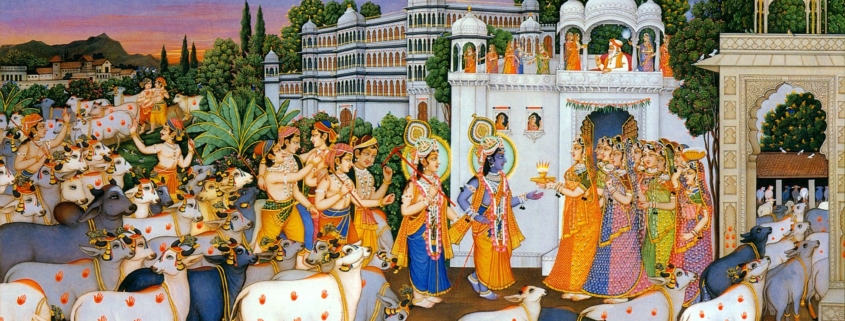
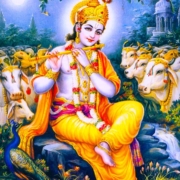
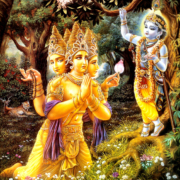
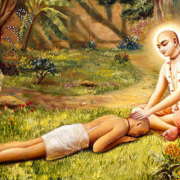
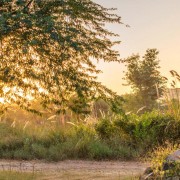
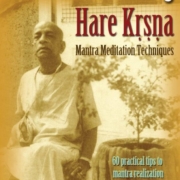

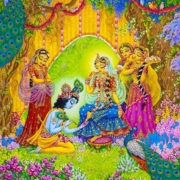


Leave a Reply
Want to join the discussion?Feel free to contribute!